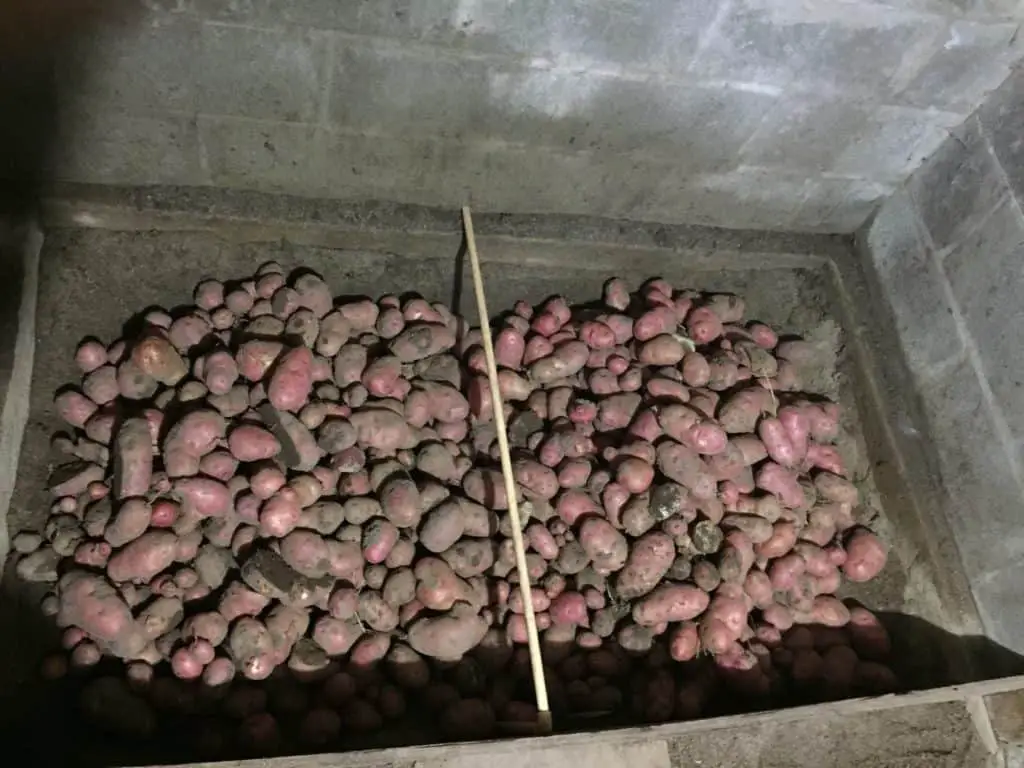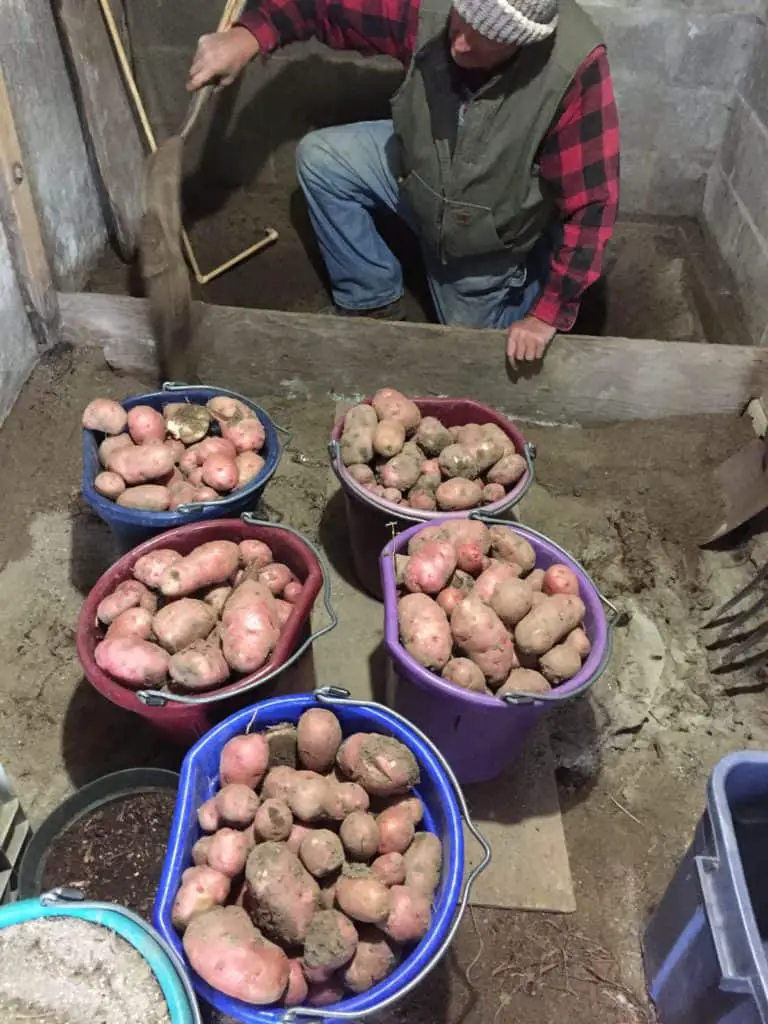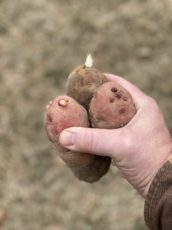If you have ever stored potatoes for any length of time you have probably experienced the potato itself beginning to sprout. A sprouted potato doesn’t taste the same at all. It changes from a starch into a sugar and becomes shriveled and mushy. The sprouts themselves can be toxic to eat.
Stopping your potatoes from sprouting is nearly impossible. There are some simple and easy practices that can slow the sprouting process down and you can keep your spuds for a bit longer and enjoy them for months.
The major things that need consideration are:
- The type or variety of potato.
- Light
- Storage temperature and humidity
- Container of the potato
- The use of essential oils to slow sprouting
The type or variety of potato
The first thing to consider is what potatoes to store. Not all potatoes are equal when it comes to storage. Some just store better than others. The potatoes with thicker skins will store for longer, but with some care and a few tricks you can keep most all potatoes for a good long time.
There are 7 basic types of potatoes and over 200 varieties with more seeming to show up every year.
The 7 basic types of potatoes are:
1- Russets
Russet potatoes are a medium to larger potato and are generally an oval or oblong shape. They are a brown color that can vary in shade from light to a medium brown. They have a light yellow or white flesh. They are excellent storage potatoes. If you grow them in your own garden, some of these potatoes become monstrous in size. One potato can feed your whole family.
2-Reds
Red potatoes are often harvested when they are small to medium and immature. They have a waxy, moist, and smooth flesh with a thin red skin. They are round or oblong in shape. However, if you grow them in your own garden you don’t have to harvest them early when they are immature. You can keep them growing and they can grow large and still keep the same characteristics as the small potato. With the proper care these potatoes will store well, but without the proper precaution they will rot, sprout, and spoil.
3-Whites
White potatoes are generally small to medium in size. They have a thin skin that looks white to light tan in color. The flesh is fairly dense and starchy. These potatoes will store well if you take the proper steps. As with most all the potatoes you can grow larger ones than typically found in the store.
4-Yellows
Yellow potatoes are anywhere from marble size to huge depending on when they are harvested. They have a light yellow/tan to golden skin. They have a waxy yellow flesh. These potatoes will store well and are becoming very popular to the home gardener and the homesteader looking for a cash crop.
5-Purple
Purple potatoes are a relatively new novel variety. They are small to medium sized round or oblong. Very distinctive with their dark purple to blue skin. The flesh is dense and firm. The flesh color can vary from pink to blue to purple. It also can vary from light to dark in color. These potatoes can also store fairly well. These varieties are often harvested when they are immature and do not store as well as if they had been harvested at maturity.
6-Fingerling
Fingerling potatoes are becoming very popular for a fun festive dish. Fingerling potatoes are small long or oblong in shape. They resemble fingers in shape, and can kind look knobby. They are all colors under the rainbow. The flesh can be red, purple, orange, white, yellow, and will sometimes have veins of color running throughout. These are heirloom potatoes and will store well depending on when you harvest them.
7-Petite
Petite potatoes are more of a size class than anything. They have been propagated from the original traditional potatoes to have a smaller size and somewhat more concentrated flavor. Most petite potatoes are potatoes that are harvested early in the season. These do not store well unless you are very careful in harvesting storage.
Most all potatoes will store well if the proper precaution is taken. However, russets, reds, and yellows have proven to be great for storing for long periods.

Storage temperature and humidity.
The temperature and humidity you store potatoes at will greatly affect the sprouting of potatoes. Most homes are much warmer than the optimal storage temperature. You will probably need to find an alternative other than the traditional storage under the sink. It’s usually just the right temperature to encourage sprouting.
The optimal temperature for storing potatoes is 42-50 degrees Fahrenheit. Some research has been done to show that 38 degrees Fahrenheit will deter sprouting, but you start to risk changing the starch of the potato into sugar at that temperature. The colder you store the potato the browner the flesh is when cooked. If you freeze the potato the flesh will turn grey.
The humidity is also important to consider. A potato is about 80% water. Potatoes need to be stored in a humid location to prevent them from drying out. Commercially potatoes are stored at 90-95% humidity. Most homes are not this humid, but humidity can be increased with a cellar or storage pit. Also the container used could help regulate the humidity. Plastic for instance could hold in more humidity, but it also will not allow for the potato to breathe. Tis can result in spoiled potatoes. I talk a little more about containers later in the article.
Light
You need to store potatoes in a dark place without light. Potatoes are a plant and they do respond to light. The more light the more chance of the potato reacting and sprouting. The dimmer the better.
Containers
Potatoes will store better with air circulation. This will help regulate both temperature and humidity. The better regulated these things are the less sprouting you will have. You will need to consider what kind of container to store your spuds in.

Often you will find potatoes in plastic bags when you buy them from the store. Plastic bags or buckets will increase the humidity and not allow for airflow. This can induce stress and trigger the potatoes to sprout, or rot.
A better idea would be to use paper sacks, cardboard boxes, perforated sacks, gunny or burlap sacks, or piled on sandy soil. If you are using a really dry storage area you can use plastic to your benefit to keep the storage more humid and not dry out the potatoes.
We personally use a well-ventilated root cellar. We grow and harvest our own potatoes and store them in a pit lined with sandy soil. This has worked well to keep the sprouting from happening. When spring hits and the cellar warms up due to the ambient temperature the potatoes will sprout, but as long as its cool the potatoes store very well without sprouting.
We purchased some russet and lasota potatoes from some local growers. They sold the potatoes in paper sacks. We store them in the paper sacks they came in alongside the potatoes in our pit. The paper sacks stored in the root cellar has worked well in hampering sprouting.
Lesser known anti sprouting hack
A lesser known anti sprouting hack is to use some essential oils. This technique has been used by a few potato growers and researchers from the University of Idaho. The essential oils used that proved to be the most effective were clove, peppermint, and spearmint oil.
All these essential oils have been approved by the FDA to be safe. This is proving to be a safe organic option to control potato sprouting. These oils were found to damage rapidly dividing cells in the sprouts and prevented the potatoes from sprouting.
The research was done for big commercial growers, but the home gardener and small homesteader can use this as well. The method for home gardeners and homesteaders is a wick method. This is where you use blotter paper or unprinted newsprint soaked with the oil and put it into the box with the potatoes. You will need to reapply the oil at two to three week intervals to keep the potatoes from sprouting.
Clove, spearmint, and peppermint, oils were all found to be effective. They were also found to flavor the potatoes as well. The one that was found to leave little to no flavor to the potato was peppermint oil. The others would add flavor to the potatoes. So you may want to stay away from clove and spearmint oil unless you want clove and spearmint tasting spuds.
If you try this technique timing is important. You need to begin the process before the potatoes begin to sprout. This will stop the whole sprouting process before it begins.

